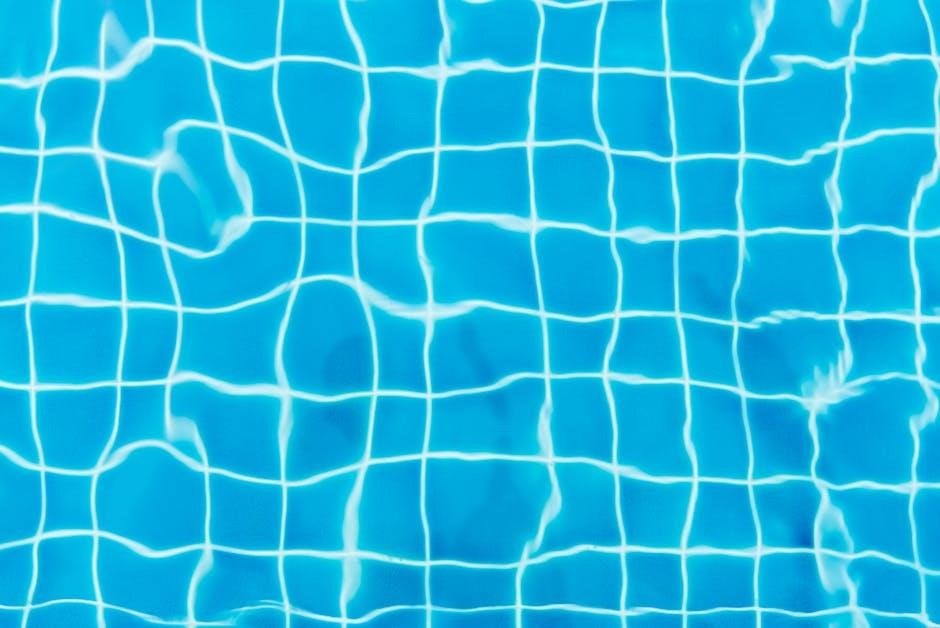Intex Pool Installation: A Comprehensive Guide

Ready for a backyard oasis? This guide simplifies Intex pool setup, from choosing the right spot to enjoying a refreshing dip. Follow these steps for a smooth installation and a summer filled with fun and relaxation. Get ready to transform your yard!
Initial Preparations

Before diving into the installation of your Intex pool, meticulous preparation is key for a successful and enjoyable experience. This initial phase ensures a smooth process and helps prevent potential issues down the line. Start by carefully reviewing the Intex pool installation instructions included with your specific model. Familiarize yourself with all the components and steps involved. This will provide a clear roadmap for the entire project. Next, conduct a thorough inventory of all the parts listed in the manual. This includes the pool liner, frame components (if applicable), filter pump, hoses, and any accessories. Ensure that you have everything on hand before proceeding. If any parts are missing or damaged, contact Intex customer support for replacements before starting the installation. Proper planning and preparation will save you time and frustration in the long run. Gather all the necessary tools and materials. Depending on your pool model and the condition of your chosen location, you may need items such as a shovel, level, measuring tape, tamper, sand (for leveling), ground cloth, and a rubber mallet. Having these tools readily available will streamline the installation process. Finally, check the weather forecast and choose a day with favorable conditions for the installation. Avoid setting up the pool during strong winds or heavy rain. A calm and clear day will make the task much easier and safer. By completing these initial preparations, you’ll be well-equipped to proceed with the installation of your Intex pool and enjoy a refreshing escape in your backyard.
Choosing the Right Location
Selecting the ideal location for your Intex pool is a critical step that directly impacts the pool’s longevity, safety, and overall enjoyment. Careful consideration of several factors is essential to ensure a positive swimming experience for years to come. First and foremost, prioritize a level surface. An unlevel ground can cause structural stress on the pool frame, leading to instability and potential damage. Use a level to check the ground in multiple directions, and be prepared to level the area if necessary (more on this in the next section). Avoid areas with significant slopes or uneven terrain. Next, consider the proximity to trees and overhead power lines. Trees can drop leaves, twigs, and sap into the pool, increasing maintenance efforts. Furthermore, tree roots can potentially damage the pool liner over time. Overhead power lines pose a serious safety hazard and should be avoided at all costs. Ensure that the chosen location is free from any obstructions, both above and below ground. Accessibility to a water source and a power outlet is also crucial. You’ll need a hose to fill the pool and an electrical outlet to power the filter pump. Choose a location that allows for convenient access to both. Think about sun exposure. While you’ll likely want some sun for swimming, excessive exposure can heat the water too much and fade the pool liner. Consider a location that offers a balance of sun and shade throughout the day. Finally, take into account local regulations and homeowner association rules. Some areas may have restrictions on pool placement, size, or fencing requirements. Check with your local authorities before proceeding with the installation. By carefully evaluating these factors, you can select the perfect location for your Intex pool, ensuring a safe, enjoyable, and hassle-free swimming experience.
Ground Preparation and Leveling
Proper ground preparation and leveling are paramount for a successful and long-lasting Intex pool installation. This stage ensures the pool’s structural integrity, prevents potential damage, and contributes to a safe and enjoyable swimming experience. Start by clearing the chosen area of all debris, including rocks, sticks, roots, and any other sharp objects. These items can puncture the pool liner and compromise its durability. Remove any grass or vegetation within the pool area, as these can decompose and create unevenness over time. Once the area is clear, it’s time to level the ground. Use a long, straight board (a 2×4 works well) and a level to identify high and low spots. The goal is to create a perfectly flat and even surface. For minor imperfections, you can use a shovel to remove soil from high spots and fill in low spots. Compact the soil with a hand tamper or a roller to ensure a firm base. For more significant leveling issues, you may need to bring in additional topsoil. Spread the topsoil evenly and compact it thoroughly. Recheck the levelness with the board and level, making adjustments as needed. It’s crucial to be patient and meticulous during this process. A well-leveled ground is the foundation for a stable and secure pool. Once the ground is level, consider adding a layer of sand or a pool pad to protect the liner. Sand provides a soft cushion and helps prevent punctures from any remaining small objects. A pool pad offers even greater protection and can also help insulate the pool water, reducing heat loss. Spread the sand or pool pad evenly over the leveled area. Finally, double-check the levelness one last time before proceeding with the pool installation. Any remaining imperfections can be addressed at this stage. Remember, investing the time and effort in proper ground preparation and leveling will pay off in the long run, ensuring a safe, stable, and enjoyable Intex pool experience.
Unpacking and Inventory
Before you begin the exciting process of assembling your Intex pool, it’s crucial to take the time to unpack all the components and meticulously inventory them. This step is essential to ensure that you have everything you need for a smooth and hassle-free installation. Start by carefully opening the pool packaging and laying out all the parts in an organized manner. Refer to the parts list included in the Intex pool manual. This list provides a detailed breakdown of all the components, including the frame pieces, liner, filter pump, hoses, ladder (if included), and any other accessories. Systematically compare each item you unpack with the corresponding item on the parts list. As you identify each part, check it off on the list. Pay close attention to the quantities of each item. For example, make sure you have the correct number of frame legs, connectors, and liner patches. Carefully inspect each component for any signs of damage. Check the frame pieces for dents, bends, or cracks. Examine the liner for tears, punctures, or weak spots. If you find any damaged parts, contact Intex customer service immediately for replacements. Do not attempt to install the pool with damaged components, as this could compromise its structural integrity and safety. Organize the parts into groups based on their function. For example, keep all the frame pieces together, the liner separate, and the filter pump components in another area. This will make the assembly process much easier and more efficient. Store the parts in a safe and dry location, away from direct sunlight and extreme temperatures. This will help prevent damage or deterioration of the materials. Keep the Intex pool manual readily accessible, as you will need it for reference during the assembly process. The manual provides detailed instructions and diagrams that will guide you through each step of the installation. Taking the time to unpack and inventory all the components before you begin the installation will save you time and frustration in the long run. It will also ensure that you have everything you need to get your Intex pool up and running smoothly.
Frame Assembly (Ultra XTR/Prism Frame)
The frame assembly is a critical step in setting up your Intex Ultra XTR or Prism Frame pool. A properly assembled frame ensures the pool’s stability and structural integrity, allowing it to safely hold water. Begin by laying out all the frame components on a clean, flat surface. Refer to the Intex pool manual for a detailed diagram of the frame assembly. The manual will show you the correct orientation and connection points for each piece. Start by connecting the horizontal beams that form the top ring of the pool. These beams are typically connected using T-connectors or locking pins. Ensure that the connections are secure and that the beams are aligned properly. Next, attach the vertical legs to the horizontal beams. The legs provide support for the pool walls and distribute the weight of the water evenly. Make sure the legs are spaced evenly around the perimeter of the pool. Use the locking pins or bolts provided to secure the legs to the beams. Tighten all connections to ensure that the frame is sturdy and stable. As you assemble the frame, double-check that all the pieces are properly aligned and that the connections are secure. A misaligned or loose connection can weaken the frame and cause it to collapse under the weight of the water. For Ultra XTR pools, pay close attention to the Easy Lock System. This system allows you to connect the frame pieces without the need for tools. Simply align the pieces and snap them together. Make sure the locking mechanism is engaged properly to ensure a secure connection. For Prism Frame pools, you may need to use bolts and nuts to connect the frame pieces. Use a wrench to tighten the bolts, but be careful not to overtighten them, as this could damage the frame. Once the frame is fully assembled, inspect it carefully for any signs of weakness or instability. If you notice any problems, correct them before proceeding to the next step. Ensure that the frame is level and that all the legs are resting firmly on the ground. If the ground is uneven, use shims to level the legs. A level frame is essential for maintaining the pool’s shape and preventing leaks. With the frame properly assembled, you can now move on to installing the pool liner. This is another critical step in the installation process, so be sure to follow the instructions in the Intex pool manual carefully.

Liner Installation and Wrinkle Removal
Installing the pool liner correctly and removing wrinkles is crucial for a smooth pool surface and to prevent damage. Start by carefully unfolding the liner inside the assembled frame, centering it as much as possible. The goal is to distribute the material evenly around the pool’s circumference. Ensure the drain fitting is positioned in the desired location within the frame before you fully unfold the liner. With the liner unfolded, begin carefully tucking the top edge of the liner over the frame’s top horizontal beams. Work your way around the pool, ensuring the liner is evenly distributed. Smooth out any large creases or folds as you go. Once the liner is initially in place, it’s time to tackle wrinkle removal. This is best done with a small amount of water in the pool, just enough to weigh down the liner and allow you to manipulate it. Start adding water slowly, about 1-2 inches, to the pool. As the water level rises, gently pull and smooth the liner from the outside of the pool. Focus on working the wrinkles towards the outer edges of the pool. Use your hands or feet (wearing socks to protect the liner) to smooth out the wrinkles. Be patient and persistent, as it may take some time to remove all the wrinkles. If you encounter stubborn wrinkles, try gently stretching the liner in the opposite direction. You can also use a soft brush or cloth to help smooth out the liner. Avoid using sharp objects, as they could puncture the liner. As you work, periodically check the liner’s position to ensure it remains centered within the frame. If it has shifted, gently adjust it before adding more water. Continue adding water in small increments and smoothing out wrinkles as you go. Once the water level reaches about halfway up the pool, you can take a break and let the liner settle for a few hours. This will allow the liner to stretch and conform to the shape of the pool. After the liner has settled, continue adding water and smoothing out any remaining wrinkles. Once the pool is full, inspect the liner carefully for any signs of damage or leaks. If you find any problems, contact Intex customer support for assistance. With the liner properly installed and wrinkle-free, you can now enjoy your new Intex pool. Be sure to follow the maintenance instructions in the Intex pool manual to keep your pool clean and safe.

Filling the Pool with Water
Once the liner is properly installed and wrinkle-free, it’s time to fill your Intex pool with water. This is a crucial step, so take your time and follow these instructions carefully. Before you begin, make sure the drain plug is securely in place. Connect your garden hose to the pool’s inlet fitting. Place the other end of the hose into the pool. Turn on the water slowly, allowing the pool to fill gradually. As the water level rises, continue to monitor the liner for any wrinkles or shifting. If you notice any problems, stop filling the pool and address the issue before proceeding. Use a soft brush or cloth to smooth out any wrinkles that may appear. As the pool fills, periodically check the water level to ensure it is not exceeding the maximum fill line. The maximum fill line is typically indicated on the pool liner. Do not overfill the pool, as this could damage the liner or the frame. While the pool is filling, take the opportunity to inspect the frame for any signs of stress or instability. If you notice any problems, stop filling the pool and contact Intex customer support for assistance. Once the pool is full, turn off the water and disconnect the hose. Inspect the pool again for any leaks or damage. If you find any problems, contact Intex customer support for assistance. With the pool full of water, you can now begin to enjoy your new Intex pool. However, before you jump in, there are a few more things you need to do. First, you need to install the filter pump and Hydro Aeration Technology. These are essential for keeping your pool water clean and healthy. Refer to the Intex pool manual for instructions on how to install these components. Once the filter pump and Hydro Aeration Technology are installed, you need to test the water chemistry and adjust it as needed. This is important for maintaining a safe and comfortable swimming environment. You can purchase a pool water testing kit at most pool supply stores. Follow the instructions on the testing kit to test the pH, chlorine, and other chemical levels in the water. Adjust the chemical levels as needed to ensure they are within the recommended ranges. With the water chemistry balanced, you can now safely enjoy your Intex pool. Remember to follow the maintenance instructions in the Intex pool manual to keep your pool clean and safe throughout the swimming season.
Filter Pump and Hydro Aeration Technology Installation
Installing the filter pump and Hydro Aeration Technology is a crucial step in setting up your Intex pool. These components work together to keep your pool water clean, clear, and enjoyable. The filter pump removes debris and impurities from the water, while the Hydro Aeration Technology improves water circulation, filtration, and clarity, while also increasing negative ions at the water surface. Before you begin, make sure you have all the necessary parts and tools. Refer to your Intex pool manual for a complete list of parts. You will also need a screwdriver, pliers, and possibly a wrench. Start by assembling the filter pump according to the instructions in the manual. This usually involves attaching the hoses and fittings to the pump body. Once the filter pump is assembled, locate the inlet and outlet ports on your Intex pool. These ports are usually located on the side of the pool, near the top. Attach the hoses from the filter pump to the corresponding ports on the pool. Make sure the connections are tight and secure to prevent leaks. Next, install the Hydro Aeration Technology. This component typically attaches to the outlet port of the filter pump. Follow the instructions in the manual to properly install the Hydro Aeration Technology. Once the filter pump and Hydro Aeration Technology are installed, plug the filter pump into a grounded electrical outlet. Make sure the outlet is protected by a GFCI (Ground Fault Circuit Interrupter) to prevent electrical shock. Turn on the filter pump and check for any leaks. If you find any leaks, tighten the connections or replace the faulty parts. Allow the filter pump to run for several hours to circulate and filter the water; Regularly clean the filter cartridge to maintain optimal performance. Refer to your Intex pool manual for instructions on how to clean the filter cartridge. By following these steps, you can successfully install the filter pump and Hydro Aeration Technology and enjoy clean, clear, and healthy pool water all season long. Remember to always consult your Intex pool manual for specific instructions and safety precautions.